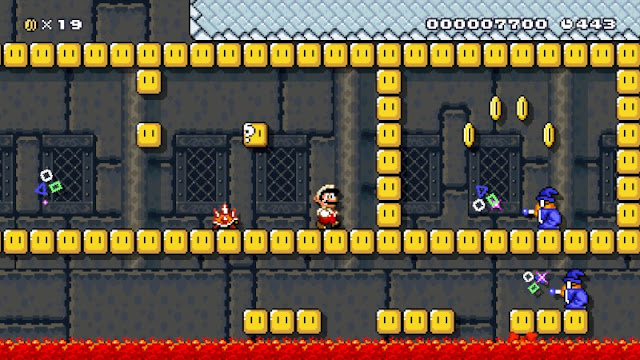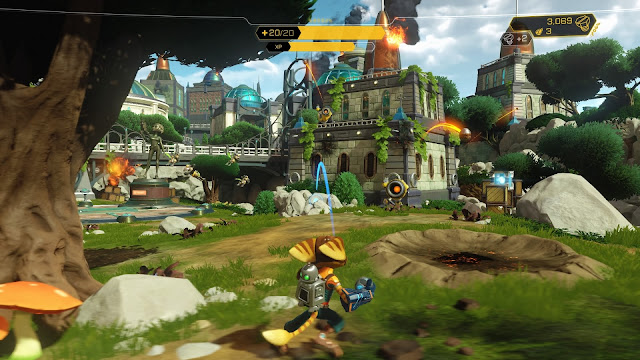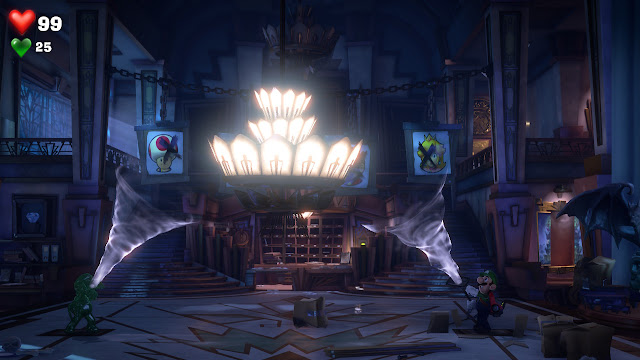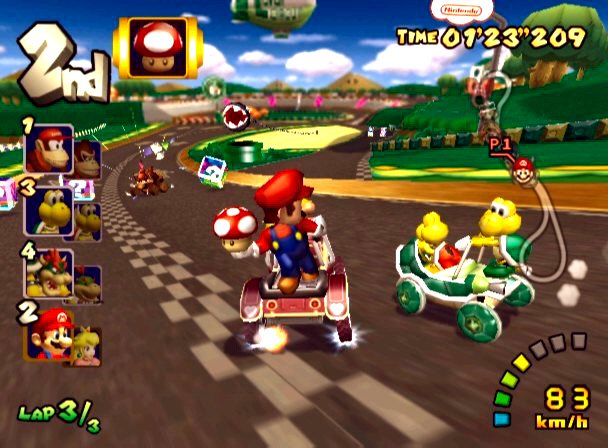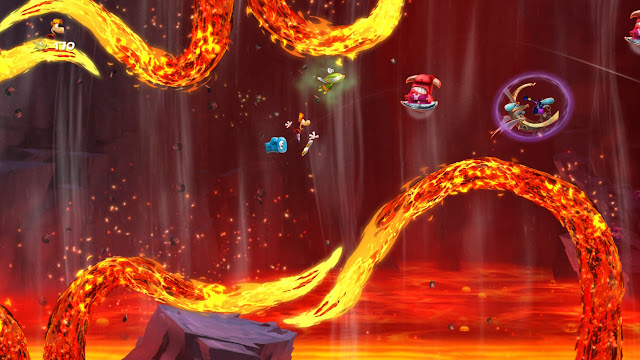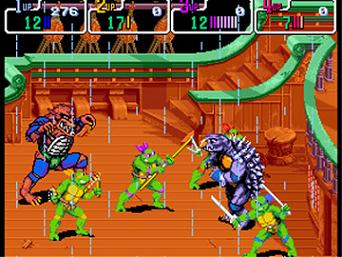Welcome to the beginning of SuperPhillip Central's 13th anniversary celebration! This entire weekend dedicates itself to the celebration of SPC being online for 13 years now. Today of all days is the actual anniversary of SuperPhillip Central. 13 years ago, on June 5th, 2008, SuperPhillip Central debuted. It was a much smaller scale, much less professional (well, if you can even imagine that since SPC isn't the most professional gaming site around even to this day!) site, and now we've grown quite considerably over the past decade and some change.
This weekend features a couple of unique articles to help commemorate the 13th anniversary, and that begins this morning with a trip back in time. For the past 13 years and at the conclusion of every calendar year, SuperPhillip Central does another kind of celebration--this time of the best and brightest in gaming for that year. It's always the SuperPhillip Central Best of [insert year here] Awards! For this first special anniversary article, I've decided to take a look back at each of the previous 13 games awarded SPC's prestigious Game of the Year honors and see what my thoughts are about them in 2021. So, let's get started, shall we!
Game of the Year 2008: LittleBigPlanet (PS3)
What I said then:
"With 40 cleverly concocted levels already in the game from Media Molecule to explore and collect costumes, stickers, and level pieces in, one of the deepest level creators ever seen on a console, and a multitude of users designing mind-boggingly awesome levels both based off games and totally unique, LittleBigPlanet is my personal Game of the Year. It was a close race with Brawl as both games scored the same, but not only is LBP a new franchise but it's one that I've already spent an exhaustive amount of time creating levels and playing online with friends."
What I say now:
It's quite bizarre to think that 13 years ago I was doing my very first SuperPhillip Central Best of... Awards show. Time certainly does fly. It's less bizarre, however, that my pick for the Game of the Year for 2008 was none other than the original LittleBigPlanet. For one, it checked the box of being in my favorite genre: the platformer, and for another thing, it incorporated some of the most incredible and infinitely ingenious and full of sensational tools to help players make crafty creations, whether unique objects for full-scale levels. While later games in the series, particularly LittleBigPlanet 2, have since outshined and out-crafted the original LBP, I still hold Media Molecule's original opus with high regard an even higher esteem.
Game of the Year 2009: New Super Mario Bros. Wii (Wii)
What I said then:
"Another platformer earns game of the year. I must be sensing a pattern here. Regardless, with over seventy-five levels, nine worlds (one hidden), multiple cool power-ups like the awesome propeller cap that lets your hover and float in the air for a limited time, catchy music, and a bounty of hilarious multi-player experiences, there's no doubt in my mind that New Super Mario Bros. Wii is the game of the year."
What I say now:
This is another case of a game that won Game of the Year honors at SuperPhillip Central that has since had better, more improved sequels. It's certainly true that New Super Mario Bros. Wii remains an excellent entry in the 2D Mario series, as it's astonishingly capable and magnificent on a level design basis, but for me, New Super Mario Bros. U on Wii U surpassed it in quality. Does that mean I would change my thoughts about the Wii entry today and perhaps change what I would have chosen as Game of the Year for 2009? Absolutely not. New Super Mario Bros. Wii, though as much as it's easy to ignore and forget, introduced so many--for lack of a better word--NEW things within 2D Mario like multiplayer and various power-ups, that it's hard to ignore how important it is to the series' evolution. Or, depending on who you are, lack thereof with regards to evolution.
Game of the Year 2010: Super Mario Galaxy 2 (Wii)
What I said then:
"With more diversity than any other game released this year, Super Mario Galaxy 2 is the ultimate video game. It's what video games are foremost all about. Not story, not heavy-handed cinematics, or intense violence, but FUN! And Super Mario Galaxy 2 delivers fun in spades. Nintendo EAD once again shows while they are the kings of video game design with this incredibly enjoyable, colorful 3D platformer. There is no better game this year, and there was some tough competition."
What I say now:
Another Mario game getting top honors at SuperPhillip Central, Super Mario Galaxy 2 did indeed show Nintendo EAD as a top talent within the gaming sphere, especially with regard to platformers. In 2010, I increasingly showed more and more frustration as the video game industry--and often in less than mature ways--towards its focus on wanting to continue to play second fiddle to the movie industry by trying to have games be movies instead of actual games. Nowadays, it's painfully obvious to see that there's room for all kinds of experiences within the industry and our hobby. If only twentysomething year-old me understood that back then. Regardless, and excuse my diatribe there, Super Mario Galaxy 2 presented players with essentially an expansion. It was Super Mario Galaxy but MORE--more levels, more innovative and unique ideas, more challenge, and really, more fun.
Game of the Year 2011: The Legend of Zelda: Skyward Sword (Wii)
What I said then:
"The Wii may have went more with quality than quantity in 2011, but it possesses the exclusive that beats out the rest with The Legend of Zelda: Skyward Sword. Following a touching and charming story of finding Link's lost friend Zelda, this entry to this beloved franchise showcases five years of Nintendo's efforts in motion control. What most of us thought the Wii would be at its launch has finally been realized with Skyward Sword. From the intuitive swordplay to the tightrope walking, the bomb rolling and throwing to the wall climbing, and the fluid swimming to the weapon aiming, Skyward Sword shows an unprecedented amount of love and polish in its controls and gameplay making it my choice for Game of the Year 2011."
What I say now:
Again, time certainly does fly. Ten years ago I was awarding The Legend of Zelda: Skyward Sword with Game of the Year honors, and now this July we have Skyward Sword HD slashing and slicing its way onto the Switch. The culmination of the promise that was the Wii's motion controls, Skyward Sword offered unprecedented awesomeness in its myriad Wii Remote uses. Nearly every means to control the world within Skyward Sword used motion controls in profound and generally fantastic feeling ways. However, as an experience, this Zelda game really hit home the notion and realization that the series as a whole needed some serious shaking up as it was getting a bit long in the tooth. Who knows if the Zelda series ever got that much needed shaking up, after all! (Wink, wink!)
Game of the Year 2012: Xenoblade Chronicles (Wii)
What I said then:
"In a genre that is hard for me to stick with most games, Xenoblade Chronicles hooked me in for the long haul, throughout its 100+ hours of gameplay. With most RPGs, I find myself losing interest a good way through because the game can't keep my engaged. With Xenoblade Chronicles, that wasn't a problem. There was always one hard enemy I wanted to take down, one path through an expansive dungeon or area that I wanted to explore, or one quest that I wanted to complete. Everything about Xenoblade Chronicles is near perfection: the awesome soundtrack (which did win runner-up for Best Original Soundtrack this year, after all), the well done voice acting, the jaw-dropping locales that are rich and ripe for venturing through, and the appealing combat system that demands your attention and great teamwork. Xenoblade Chronicles is without any question my favorite game of 2012. It was a fond farewell to the under-appreciated Wii."
What I say now:
Another game that has already seen a Nintendo Switch HD remaster, the original Xenoblade Chronicles on Wii and by extension its New Nintendo 3DS port are now pretty much redundant when there's a much better, much more improved, much prettier version to be found on the Switch. Nevertheless, the original Xenoblade Chronicles was a breath of fresh air for me as a Wii owner in 2012. I hadn't experienced such an open world before, teeming with secrets, lovely locales, and dangerous creatures that could one shot my party if I strayed too closely to them. It's just amazing to me how this game required a fan campaign to get localized over here, and Nintendo of America begrudgingly accepted, though releasing the game in short supply. Now, Xenoblade is one of Nintendo's most important franchises, and the publisher even eventually purchased Monolith Soft due to the game's success. While I vastly prefer the Switch remaster, there's no question that the Wii game was something truly special back in 2012, and really, it still is.
Game of the Year 2013: The Legend of Zelda: A Link Between Worlds (3DS)
What I said then:
"For the first time in SuperPhillip Central history our Game of the Year comes from a handheld device. The Legend of Zelda: A Link Between Worlds was a welcome change to the typical formula of the Zelda series. It offered an amount of freedom that made modern Zelda games before it look like they had the amount of freedom of wearing a straitjacket. Being able to rent and then buy items for Link's arsenal meant the world was open for Link to explore, and in Lorule the order of dungeons could be determined by the player. The excessive hand-holding of past games was gone, as was the severe linearity so many Zelda games prior had suffered from. The incredibly quick pacing also was like a breath of fresh Hyrulean air. Combine this with some brilliant dungeon design, familiar locales, an awesome new wall merge gameplay mechanic, and creative boss battles, and you have what we considered to be a genuinely easy choice for our Game of the Year for this sixth annual awards ceremony."
What I say now:
The Legend of Zelda: A Link Between Worlds is a Zelda game I consistently come back to, as it's nearly everything that I loved about past 2D Zelda games, only presented in a much more palatable format. The ability to explore dungeons any order you wanted, and freely explore both Hyrule and Lorule, basically shows that A Link Between Worlds was both a bridge and a link between the classic Zelda experience and the more open-ended structure we've seen with Breath of the Wild. The wall-merging mechanic remains one of my favorite gameplay mechanics in a Zelda game, as it really forced players to think in multiple dimensions and was just cool to boot! With a colorful art style, a brilliantly realized world and series of dungeons, and a stellar soundtrack that I love listening to-to this day, The Legend of Zelda: Breath of the Wild isn't just Game of the Year for 2013 on SPC, it's one of my favorite games to this day to play.
Game of the Year 2014: Super Smash Bros. for Wii U (Wii U)
What I said then:
"After the relative disappointment that fans experienced with Super Smash Bros' showing on the Wii with Brawl, many felt that they were owed a better game from the ever-hardworking Masahiro Sakurai and his team. Well, while I wasn't one of these people, I definitely am of the opinion that Sakurai and friends achieved practical perfection with Super Smash Bros. for Wii U, a game which not only plays well for both casual and competitive players (and everyone in between), but it is an absolute love letter to any fan of Nintendo history. Super Smash Bros. for Wii U is jam-packed with content-- so much so that even after nearly a hundred hours of playing the game I have yet to see all that there is to see. Most importantly, though, this new console version of Smash Bros. is just an amazing pleasure to play. It feels responsive, it plays great, and it looks extraordinary, making it my favorite game of 2014."
What I say now:
It says more about the type of gaming year 2014 was that one of my least favorite Super Smash Bros. games was Game of the Year back then. Not to say that Super Smash Bros. for Wii U is a terrible entry in the franchise. It's simply not as innovative or as strong as past or even future entries. If I had to select a new Game of the Year, if such a hypothetical scenario was presented to me, I'd probably swing towards Mario Kart 8 or Donkey Kong Country: Tropical Freeze as my picks that had more of an impact on me. That said, I did enjoy a lot about the Wii U incarnation of Smash Bros., as it offered loads of lovely stages, an enhanced roster with some of my favorite additions in the series such as Mega Man, Little Mac, Rosalina, and more, and was the most recent entry featuring those sensationally awesome collectibles--trophies. Sure, Super Smash Bros. Ultimate has since redefined what the Smash Bros. can and should be, but there's no doubting that I had a serious love for the Wii U entry back in 2014.
Game of the Year 2015: Super Mario Maker (Wii U)
What I said then:
"Probably the game I spent the most time with in 2015 was also the one that I enjoyed playing the most. It's Super Mario Maker, and I can't help but keep coming back to this delightful game. It's more than a game, though. It's a level creator to make Mario levels in. While that concept is by no means new, Nintendo somehow managed to make the arduous process of creating games and make it fun, accessible, and easy for anyone to do. Whether you're wanting to create articulated masterpieces of levels or just want to mess about with the level creator, fun is a few seconds away as soon as you pop in that Super Mario Maker disc into your Wii U. Even after several months of playing the game, I still see myself coming back to Super Mario Maker, playing others' levels, getting ideas for my own works, and creating some courses of my own. These reasons and more are why Super Mario Maker is SuperPhillip Central's Game of the Year 2015."
What I say now:
Although Super Mario Maker is quite basic in comparison to its Switch sequel, I cannot ignore how much of a revelation the original Mario Maker was back in 2015, nor the amount of hours I spent dilly-dallying around with the ultra-accessible creation tools. Anyone could make the levels of their dreams, and this particular anyone did. Sure, missing objects like slopes and even checkpoints at launch for the latter stifled some creativity for many, but the pure joy and the novelty of being able to almost effortlessly create a Mario level from scratch was truly something special to behold. Since its launch, the Wii U servers have since gone offline, so many of us original Mario Maker creators have moved on to the Switch sequel, which just so happens to have been runner-up for GotY for 2019.
Game of the Year 2016: Ratchet & Clank (PS4)
What I said then:
"A franchise that was getting a little long in the tooth due to multiple near-yearly releases, Ratchet & Clank got the reboot button blasted down hard, just in time, and the end result is my favorite game from 2016. This hybrid of tight platforming and run and gun shooting with engaging and often exotic weaponry offered intense gameplay with a dash of slower paced sections as a nice palette cleanser from time to time. Although the number of planets was less than past games in the series, each one was stocked to the brim with personality, character, beauty, content, and secrets. The game also retained the series' trademark humor and off-the-wall characters. All of these things added up to me having a difficult time putting the game down, especially when playing through the game multiple time was so rewarding, especially upgrading weapons and adding to my bolt count. If anything, Ratchet & Clank proves that you can teach an old lombax new tricks, and it makes me eager to see where developer Insomniac Games takes the series next, because this first taste of Ratchet and his robot buddy Clank on the PS4 has left me seriously aching for more."
What I say now:
Ratchet & Clank is one of, if not my absolute favorite franchise in the PlayStation first-party powerhouse of properties. It combines intense weapon-based action with humorous writing and clever platforming and gadgetry to create a series with much more hits and than misses. It's a series that I buy PlayStation consoles for--as Future Tools of Destruction got me into buying a PS3, and then 2016's Ratchet & Clank got me into seeking out a PS4. The latter was most definitely worth the $400+ price of admission to the PlayStation 4 ecosystem, as not only did I get a whole slew of excellent games on my PS4 throughout the years, but also Ratchet & Clank's 2016 entry was a stupendously solid, wonderfully fun and well executed game. It is one that I still think highly of to this day, and routinely return to it to revisit and unwind with. It may have removed some of the content from the very first Ratchet & Clank, which this 2016 entry was a remake of, but really, for me, it cut out a lot of the unwanted fat and excess, while implementing lots of fresh gameplay additions to make for a better game--nay, my Game of the Year for 2016!
Game of the Year 2017: The Legend of Zelda: Breath of the Wild (NSW, Wii U)
What I said then:
"The developers basically outlined the usual gameplay and elements of the Zelda franchise on a chalkboard, took that board, and erased everything on it, eschewing old conventions to make a wholly original game that still retained that feeling, spirit, and magic of the Zelda franchise. The Legend of Zelda: Breath of the Wild bestowed on to players the most freedom seen in any series game in the past. After the initial tutorial area was completed, you were allowed to go anywhere you wanted. See that mountain? You can climb it. See that river? You can swim it. If you were prepared, you could make Breath of the Wild as hard, balanced, or as easy as you wanted in your run. Take to the fiery mountains where the Goron tribe call their home to get more challenge at the start of the game, or take it easy and head to Zora Domain after your departure from Kakariko Village.
The world was your oyster, the sandbox was yours to explore, and the various lands, areas, people, and puzzles making up the land of Hyrule all felt unique from one another. There is something to be said about a game that has flaws that don't tarnish the overall experience for me. The Legend of Zelda: Breath of the Wild is no perfect game, but what it is - is a gameplay experience, memorable journey, exciting adventure, and lovely game world that has now rivaled some of my favorite games ever made."
What I say now:
Like many of you out there, I was absolutely floored by The Legend of Zelda: Breath of the Wild and wait with bated... well, breath for any word of the sequel. I put over 80 hours into Breath of the Wild, and even then, that's on the shallow end of the pool of playtime that many of you have gotten out of the game. I no doubt wish to return to the kingdom of Hyrule to explore the Great Plateau once more, enter into Hateno Village again, roam the seaside, and many mountainous areas. Even with my somewhat sizable 80 hours of playtime with Breath of the Wild, I just hit the tip of the iceberg as to discovering the world. There's so much to see, so much to do, and so much to uncover that simply writing this description of what I say about the game now makes me want to start a new playthrough!
Game of the Year 2018: God of War (PS4)
What I said then:
"Much like Kratos mellowed and matured from his Greek adventures, God of War as a series grew up and matured itself, too. While I would consider past God of War games to be enjoyable, well crafted "junk food" gaming experiences, this God of War is different. It's something truly special, offering a touching, heartfelt, emotional journey with Kratos and his son Atreus to reach a suitable place to lay the ashes of someone special to them both. Along the way the two's relationship goes through the necessary ups and downs and concludes in a seriously satisfying way. The gameplay eschews the faraway camera from past games, bringing forth an over-the-shoulder perspective instead, allowing for a more intimate approach. This perspective allows players to get more involved and invested with the brutality of battles, as well as invest in the jaw-dropping landscapes and environments God of War presents to players."
What I say now:
You can just imagine how big the grin on my face was when I learned that the sequel to 2018's God of War will arrive on the PlayStation 4 as well as the PS5. This is totally selfish of me, as I don't particularly have a use for a PS5 right now, but at the same time I'm glad more people will be able to enjoy whatever Sony's Santa Monica Studios creates for its sequel to SPC's Game of the Year 2018. That said, while I very much found God of War to be an incredible gaming experience, and one that successfully reinvented and revitalized the series, I would have to say that I wouldn't make it GotY for 2018 if I was choosing that honor in 2021. No, I would choose Super Smash Bros. Ultimate to fit that role, as while God of War impressed me to no end with its creative mastery, world-building and storytelling, Super Smash Bros. Ultimate is still a game I enjoy to this day. I've gotten way more bang for my buck out of Ultimate, and the game is just one of the best fighting games I've ever had the pleasure to play. The added DLC and duo of Fighter Passes has only increased my fun and admiration for the game as well. That notwithstanding, God of War remains a masterful title, and I quiver with anticipation to see what Santa Monica Studio cooks up for the sequel!
Game of the Year 2019: Kingdom Hearts III (PS4, XB1)
What I said then:
"Perhaps a big surprise as SuperPhillip Central's pick for Game of the Year 2019, considering that I don't particularly care for the nonsensical story of the series, but Kingdom Hearts III did surprise me with its excellent quality. I loved exploring the more complicated and involved level designs of the Disney worlds--unrivaled in the series by their size, scope, and density, battling tremendous creatures with the multifaceted combat which allowed different approaches to how I wanted to tackle enemies, and I was astounded by just how gorgeous of a game Kingdom Hearts III truly is, even running on just the base PS4 hardware. Moments like sailing an open world sea in the Pirates of the Caribbean world or teaming up with Buzz and Woody to take on the Heartless in the Toy Story Toy Box world hold high in my gaming memories this past year."
What I say now:
Although I was pleasantly surprised by Kingdom Hearts III and do find it to be an incredible and impressive game, especially with the added DLC that Square Enix boosted the life of the game with, I can't help but say that I wouldn't give this numbered Kingdom Hearts sequel Game of the Year honors in 2021. Instead, I'd struggle not to give Super Mario Maker 2 that title instead. Maker 2 is a game that I love due to its accessible and ultimately exponentially enjoy creation tools as is a routinely return to, unlike Kingdom Hearts III that has since been in storage on my PS4 shelf ever since beating it and obtaining the Platinum trophy. Still, I can't argue that Kingdom Hearts III didn't deserve lots of admiration from yours truly back in 2019. I absolutely adored the game, loved its open levels, side quests and activities, its more accessible combat, and insanely stupendous soundtrack, which I recently purchased on iTunes. Kingdom Hearts III may not be my pick for Game of the Year 2019 nowadays, but it's a darn tootin' great sequel and action RPG in general.
Game of the Year 2020: Animal Crossing: New Horizons (NSW)
What I said then:
"A game released at the right place and at the right time, for many, Animal Crossing: New Horizons was the perfect pandemic game. It allowed players to be social with one another in a responsible, virtual way, as they ventured to one another's islands to enjoy each other's company. The game itself is also a true and radical upgrade from past installments, offering more freedom than ever before. The ability to customize and craft your island as you see fit to truly make it your own home away from home was unprecedented for the series, and was a long awaited one, for that matter. Starting with a desolate deserted island covered with weeds at the beginning of the game and seeing it blossom and flourish into a bustling island community is one of my defining moments of 2020."
What I say now:
Seeing as I awarded Animal Crossing: New Horizons with SuperPhillip Central's Game of the Year for 2020 only six months ago, it's not too big of a surprise to see that my thoughts about one of Nintendo's top-selling Switch games has become relatively unchanged. Now, I don't really visit my island of Central much at all anymore, but that is common for me to bounce off a game after spending over 300 hours with it throughout a year's span. It's much more uncommon for me to even play a game for over 300 hours, much less do it consistently over a year! However, I did just that with New Horizons, and although I don't play the game nearly as much as I did at launch and throughout 2020, it will always hold a special place in my gaming heart as the game that helped me through the pandemic, and also simply as the game that is my favorite entry in the Animal Crossing series yet.
===
Stay tuned for more of SuperPhillip Central's 13th anniversary celebration, as more of the festivities continue this weekend!















